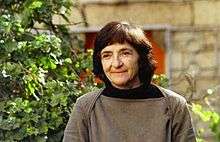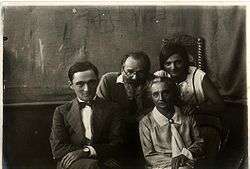Zahara Schatz
Zahara Schatz (Hebrew: זהרה ש"ץ (1916–1999), was an Israeli artist.[1] She was the daughter of Boris Schatz, who founded the Bezalel Academy of Art and Design in Jerusalem.
Zahara Schatz | |
|---|---|
 Zahara Schatz | |
| Born | 1916 |
| Nationality | Israeli |
| Education | École nationale supérieure des arts décoratifs |
| Known for | Painting |
| Movement | Israeli art |

Biography

Zohara ("Zahara") Schatz (later Sandow) was born in Jerusalem in 1916. After studying at the École nationale supérieure des arts décoratifs / National School of Decorative Arts in Paris, Schatz rose to prominence in Israel and overseas. She exhibited and won prestigious prizes in the U.S. and Europe, including at the Milan Triennale, where she won a special award, and The Museum of Modern Art in New York City, where she was recognized for a 1951 lamp design. The lamp by Heifetz Manufacturing Company, U.S., features a metal conical shade that projects light upward onto a metal disk for deflected illumination. It is one of a number of examples of her work that followed her father's dualism: the pursuit of both fine art and crafts (or design). The base of another more craft-oriented lamp is a sculptural form of a winding snake-like brass tube and bent PMMA with imbedded metal minutiae.
She also participated in the Venice Biennale of 1959 and designed the gate, built at the Bezalel Academy, of the President's House, Jerusalem.
Schatz lived in Israel, New York, and Northern California where she was part of the Big Sur artists'/writers' colony that included San Francisco sculptor Benny Bufano, author Henry Miller, and her brother Bezalel Schatz. She also lived in Berkeley, California, where she was close with Courtroom Sketch Artist Rosalie Ritz, her husband Erwin Ritz and their daughter, Publisher and Managing Editor of The Environmentalist, Janet Ritz.
Zahara and Bezalel rejected their father's predilection for Romantic Classicism and his dogged development of a Jewish Eretz Israel style in favor of a European-American modernism.[2]
She worked as an adviser on industrial design at the Israeli Ministry of Commerce and Industry.
Schatz died in Jerusalem in 1999.
Awards & recognition
- 1951: award for a table lamp, Low-Cost Lighting Competition/Exhibition, The Museum of Modern Art, New York
- 1955: Israel Prize, for painting and sculpture[3]
- 1954: medal of honor, Triennale di Milano
- 1959: Dizengoff Prize for Sculpture[4]
- 1959: participation in the Venice Biennale
- 1960: Yad Vashem Prize, for a six-branch candelabrum
- 1991: Shoshanna Ish-Shalom Prize, Jerusalem
Exhibitions
- "Zahara Schatz: A Retrospective. The Third Exhibition in the Schatz House Series, celebrating 100 Years of Israeli Art," The Artists' House, Jerusalem, 2006.
References
- "Zahara Schatz". Israel Art Guide. Retrieved 3 June 2013.
- Prof. Schatz's wayward children, Haaretz
- "Israel Prize recipients in 1955 (in Hebrew)". cms.education.gov.il (Israel Prize official website). Archived from the original on March 4, 2010.
- "List of Dizengoff Prize laureates" (PDF) (in Hebrew). Tel Aviv Municipality. Archived from the original (PDF) on 2007-12-17.
Further reading
- Eva Elisa Wardi (2005). "The poet of light, Zahara Schatz," documentary film, Jerusalem: Israel Museum, The Gabriel Scherover Information Center of Israeli Art, DVD collections, 52 min.:48 sec.
- Exhibition catalog, Gideon Ofrat (2006). Zahara Schatz 1916–999, Jerusalem: The Artists' House.
- Meir Ronnen (20 July 2006). "The last Schatz," The Jerusalem Post.
External links
- "Zahara Schatz". Information Center for Israeli Art. Israel Museum. Retrieved 6 March 2018.
- Art of Zahara Schatz at Europeana. Retrieved February 2014
- Israeli Art Guide